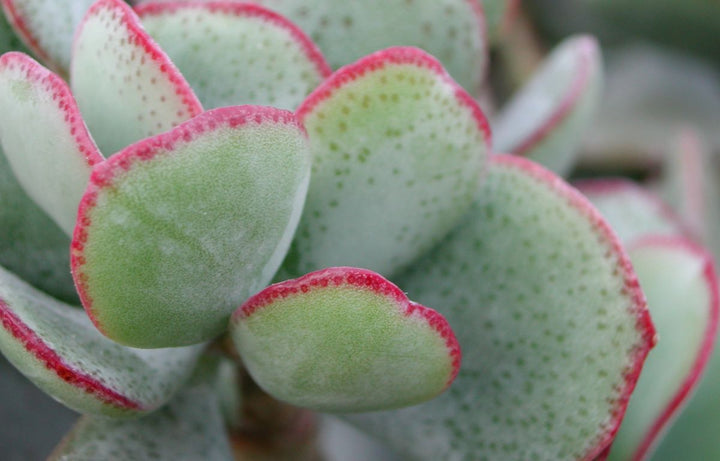
Caring for Your Crassula' Blue Bird'
Caring for Your Crassula' Blue Bird'
The Crassula' Blue Bird' is a delightful succulent that stands out with its powdery blue-green leaves and a touch of red at the tips, giving it an ethereal, almost otherworldly look. Known scientifically as Crassula arborescens, this plant is native to South Africa and is a popular choice among succulent enthusiasts and gardeners alike. It's loved for its compact, rosette-like form and its ability to add serene, cool-toned beauty to any garden or indoor plant collection.

Origin and Characteristics
Native to the rocky hills of South Africa, the Crassula arborescens have adapted to thrive in arid, sun-drenched landscapes. Its drought-tolerant nature makes it a low-maintenance plant that's perfect for those who enjoy gardening but may not have the greenest of thumbs. Its fleshy, round leaves help it store water, while the silvery-blue hue of the foliage gives it a distinctive appearance. Mature plants can develop a bushy shape, reaching up to 90 cm in height and making them a standout piece in both indoor and outdoor settings.
When properly cared for, the 'Blue Bird' may even reward you with clusters of small, star-shaped white or pink flowers in the winter months. Now, let's dig into how you can keep this beautiful succulent happy and healthy!
General Care for Crassula' Blue Bird'
Light
As a native of South Africa, Crassula' Blue Bird' thrives in bright, direct sunlight. If you're keeping it indoors, place it near a sunny window where it can soak up as much light as possible. Outdoors, it's perfect for a sunny patio or rock garden. However, if you're in an area with scorching midday sun, you may want to provide a bit of shade during the hottest part of the day to prevent sunburn on the leaves.
Watering
Like most succulents, the Crassula' Blue Bird' doesn't need a lot of water. In fact, it's better to underwater than overwater. Allow the soil to dry out completely between waterings to avoid root rot. When you do water, give it a thorough soak until water drains from the bottom of the pot. In the winter months, reduce the watering frequency as the plant enters a dormant phase.
Humidity
Being a succulent, this plant prefers dry conditions and doesn't need much humidity. Average indoor humidity is just fine, but avoid placing it in areas with excessive moisture, like a bathroom, as high humidity can encourage rot.
Soil
Well-draining soil is key to keeping your Crassula' Blue Bird' happy. A succulent or cactus mix works best, or you can create your own by mixing regular potting soil with coarse sand or perlite. The important thing is to ensure the soil doesn't stay soggy for too long.
Best Suited for Indoors or Outdoors?
Crassula' Blue Bird' is incredibly versatile and can thrive both indoors and outdoors, depending on your climate. If you live in a region with cold winters, it's best to bring the plant inside as it's not frost-tolerant. In warmer, arid climates, it will thrive outdoors all year long. Just remember to transition it slowly if moving it from inside to outside, as it will need time to adjust to the stronger light.

Common Problems and How to Solve Them
Overwatering and Root Rot
One of the most common issues with Crassula' Blue Bird' is overwatering, which can lead to root rot. The best prevention is to let the soil dry out between waterings and ensure the plant is in well-draining soil. If you notice the leaves turning yellow or mushy, it may already be suffering from root rot. To save the plant, you'll need to remove it from its pot, cut away the affected roots, and repot it in fresh, dry soil.
Sunburn
Too much direct sunlight can cause sunburn, especially if the plant is suddenly exposed to stronger outdoor light. You'll notice sunburn as brown or white patches on the leaves. To prevent this, gradually acclimate your Crassula to more intense light and provide partial shade during peak sun hours.
Pests
Crassula' Blue Bird' is relatively pest-resistant, but it can occasionally attract mealybugs or aphids. These pests usually show up on the undersides of leaves or in crevices. The best solution is to wipe the plant with a cotton swab dipped in rubbing alcohol, which will kill the pests on contact.
Three Fun Facts About Crassula' Blue Bird'
- Natural Sunscreen: The silvery-blue coating on its leaves acts like sunscreen, protecting the plant from intense sunlight. This layer is called "epicuticular wax" and can rub off, so handle the plant with care.
- Winter Bloomer: Unlike many plants that bloom in spring or summer, Crassula' Blue Bird' tends to flower in the winter, offering a burst of colour when most gardens are resting.
- Living Air Filter: Like many succulents, Crassula' Blue Bird' helps purify the air by absorbing carbon dioxide and releasing oxygen, making it a great plant to keep indoors.
Keen to read more? Check out this blog post on the Guppy Plant
